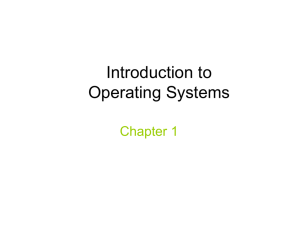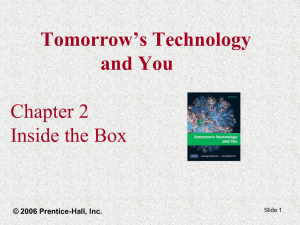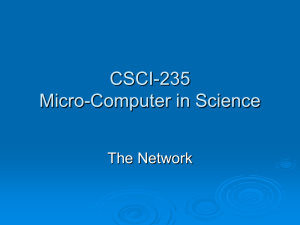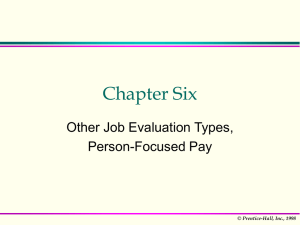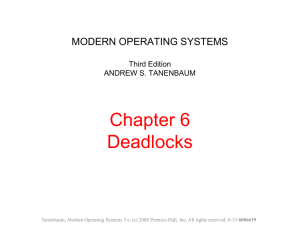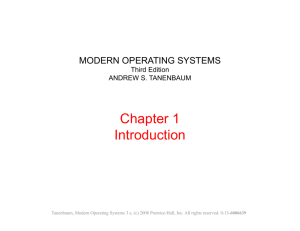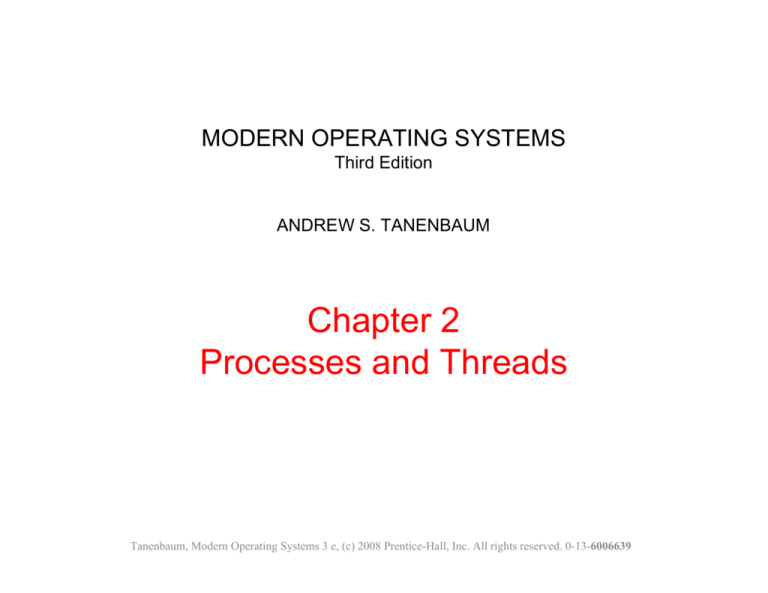
MODERN OPERATING SYSTEMS
Third Edition
ANDREW S. TANENBAUM
Chapter 2
Processes and Threads
Tanenbaum, Modern Operating Systems 3 e, (c) 2008 Prentice-Hall, Inc. All rights reserved. 0-13-6006639
The Process Model
Figure 2-1. (a) Multiprogramming of four programs. (b) Conceptual
model of four independent, sequential processes. (c) Only
one program is active at once.
Tanenbaum, Modern Operating Systems 3 e, (c) 2008 Prentice-Hall, Inc. All rights reserved. 0-13-6006639
Process Creation
Events which cause process creation:
•
•
•
•
System initialization.
Execution of a process creation system call by a
running process.
A user request to create a new process.
Initiation of a batch job.
Tanenbaum, Modern Operating Systems 3 e, (c) 2008 Prentice-Hall, Inc. All rights reserved. 0-13-6006639
Process Termination
Events which cause process termination:
•
•
•
•
Normal exit (voluntary).
Error exit (voluntary).
Fatal error (involuntary).
Killed by another process (involuntary).
Tanenbaum, Modern Operating Systems 3 e, (c) 2008 Prentice-Hall, Inc. All rights reserved. 0-13-6006639
Process States
Figure 2-2. A process can be in running, blocked, or ready state.
Transitions between these states are as shown.
Tanenbaum, Modern Operating Systems 3 e, (c) 2008 Prentice-Hall, Inc. All rights reserved. 0-13-6006639
Implementation of Processes (1)
Figure 2-3. The lowest layer of a process-structured operating
system handles interrupts and scheduling. Above that layer
are sequential processes.
Tanenbaum, Modern Operating Systems 3 e, (c) 2008 Prentice-Hall, Inc. All rights reserved. 0-13-6006639
Implementation of Processes (2)
Figure 2-4. Some of the fields of a typical process table entry.
Tanenbaum, Modern Operating Systems 3 e, (c) 2008 Prentice-Hall, Inc. All rights reserved. 0-13-6006639
Implementation of Processes (3)
Figure 2-5. Skeleton of what the lowest level of the operating
system does when an interrupt occurs.
Tanenbaum, Modern Operating Systems 3 e, (c) 2008 Prentice-Hall, Inc. All rights reserved. 0-13-6006639
Modeling Multiprogramming
Figure 2-6. CPU utilization as a function of the number of
processes in memory.
Tanenbaum, Modern Operating Systems 3 e, (c) 2008 Prentice-Hall, Inc. All rights reserved. 0-13-6006639
Thread Usage (1)
Figure 2-7. A word processor with three threads.
Tanenbaum, Modern Operating Systems 3 e, (c) 2008 Prentice-Hall, Inc. All rights reserved. 0-13-6006639
Thread Usage (2)
Figure 2-8. A multithreaded Web server.
Tanenbaum, Modern Operating Systems 3 e, (c) 2008 Prentice-Hall, Inc. All rights reserved. 0-13-6006639
Thread Usage (3)
Figure 2-9. A rough outline of the code for Fig. 2-8. (a) Dispatcher
thread. (b) Worker thread.
Tanenbaum, Modern Operating Systems 3 e, (c) 2008 Prentice-Hall, Inc. All rights reserved. 0-13-6006639
Thread Usage (4)
Figure 2-10. Three ways to construct a server.
Tanenbaum, Modern Operating Systems 3 e, (c) 2008 Prentice-Hall, Inc. All rights reserved. 0-13-6006639
The Classical Thread Model (1)
Figure 2-11. (a) Three processes each with one thread. (b) One
process with three threads.
Tanenbaum, Modern Operating Systems 3 e, (c) 2008 Prentice-Hall, Inc. All rights reserved. 0-13-6006639
The Classical Thread Model (2)
Figure 2-12. The first column lists some items shared by all
threads in a process. The second one lists some items
private to each thread.
Tanenbaum, Modern Operating Systems 3 e, (c) 2008 Prentice-Hall, Inc. All rights reserved. 0-13-6006639
The Classical Thread Model (3)
Figure 2-13. Each thread has its own stack.
Tanenbaum, Modern Operating Systems 3 e, (c) 2008 Prentice-Hall, Inc. All rights reserved. 0-13-6006639
POSIX Threads (1)
Figure 2-14. Some of the Pthreads function calls.
Tanenbaum, Modern Operating Systems 3 e, (c) 2008 Prentice-Hall, Inc. All rights reserved. 0-13-6006639
POSIX Threads (2)
...
Figure 2-15. An example program using threads.
Tanenbaum, Modern Operating Systems 3 e, (c) 2008 Prentice-Hall, Inc. All rights reserved. 0-13-6006639
Implementing Threads in User Space
Figure 2-16. (a) A user-level threads package. (b) A threads
package managed by the kernel.
Tanenbaum, Modern Operating Systems 3 e, (c) 2008 Prentice-Hall, Inc. All rights reserved. 0-13-6006639
Hybrid Implementations
Figure 2-17. Multiplexing user-level threads
onto kernel-level threads.
Tanenbaum, Modern Operating Systems 3 e, (c) 2008 Prentice-Hall, Inc. All rights reserved. 0-13-6006639
Pop-Up Threads
Figure 2-18. Creation of a new thread when a message arrives.
(a) Before the message arrives.
(b) After the message arrives.
Tanenbaum, Modern Operating Systems 3 e, (c) 2008 Prentice-Hall, Inc. All rights reserved. 0-13-6006639
Making Single-Threaded Code
Multithreaded (1)
Figure 2-19. Conflicts between threads
over the use of a global variable.
Tanenbaum, Modern Operating Systems 3 e, (c) 2008 Prentice-Hall, Inc. All rights reserved. 0-13-6006639
Making Single-Threaded Code
Multithreaded (2)
Figure 2-20. Threads can have private global variables.
Tanenbaum, Modern Operating Systems 3 e, (c) 2008 Prentice-Hall, Inc. All rights reserved. 0-13-6006639
Race Conditions
Figure 2-21. Two processes want to access
shared memory at the same time.
Tanenbaum, Modern Operating Systems 3 e, (c) 2008 Prentice-Hall, Inc. All rights reserved. 0-13-6006639
Critical Regions (1)
Conditions required to avoid race condition:
•
•
•
•
No two processes may be simultaneously inside their
critical regions.
No assumptions may be made about speeds or the
number of CPUs.
No process running outside its critical region may
block other processes.
No process should have to wait forever to enter its
critical region.
Tanenbaum, Modern Operating Systems 3 e, (c) 2008 Prentice-Hall, Inc. All rights reserved. 0-13-6006639
Critical Regions (2)
Figure 2-22. Mutual exclusion using critical regions.
Tanenbaum, Modern Operating Systems 3 e, (c) 2008 Prentice-Hall, Inc. All rights reserved. 0-13-6006639
Mutual Exclusion with Busy Waiting
Proposals for achieving mutual exclusion:
•
•
•
•
•
Disabling interrupts
Lock variables
Strict alternation
Peterson's solution
The TSL instruction
Tanenbaum, Modern Operating Systems 3 e, (c) 2008 Prentice-Hall, Inc. All rights reserved. 0-13-6006639
Strict Alternation
Figure 2-23. A proposed solution to the critical region problem.
(a) Process 0. (b) Process 1. In both cases, be sure to note
the semicolons terminating the while statements.
Tanenbaum, Modern Operating Systems 3 e, (c) 2008 Prentice-Hall, Inc. All rights reserved. 0-13-6006639
Peterson's Solution
Figure 2-24. Peterson’s solution for achieving mutual exclusion.
Tanenbaum, Modern Operating Systems 3 e, (c) 2008 Prentice-Hall, Inc. All rights reserved. 0-13-6006639
The TSL Instruction (1)
Figure 2-25. Entering and leaving a critical region
using the TSL instruction.
Tanenbaum, Modern Operating Systems 3 e, (c) 2008 Prentice-Hall, Inc. All rights reserved. 0-13-6006639
The TSL Instruction (2)
Figure 2-26. Entering and leaving a critical region
using the XCHG instruction.
Tanenbaum, Modern Operating Systems 3 e, (c) 2008 Prentice-Hall, Inc. All rights reserved. 0-13-6006639
The Producer-Consumer Problem
...
Figure 2-27. The producer-consumer problem
with a fatal race condition.
Tanenbaum, Modern Operating Systems 3 e, (c) 2008 Prentice-Hall, Inc. All rights reserved. 0-13-6006639
Semaphores
...
Figure 2-28. The producer-consumer problem using semaphores.
Tanenbaum, Modern Operating Systems 3 e, (c) 2008 Prentice-Hall, Inc. All rights reserved. 0-13-6006639
Mutexes
Figure 2-29. Implementation of mutex lock and mutex unlock.
Tanenbaum, Modern Operating Systems 3 e, (c) 2008 Prentice-Hall, Inc. All rights reserved. 0-13-6006639
Mutexes in Pthreads (1)
Figure 2-30. Some of the Pthreads calls relating to mutexes.
Tanenbaum, Modern Operating Systems 3 e, (c) 2008 Prentice-Hall, Inc. All rights reserved. 0-13-6006639
Mutexes in Pthreads (2)
Figure 2-31. Some of the Pthreads calls relating
to condition variables.
Tanenbaum, Modern Operating Systems 3 e, (c) 2008 Prentice-Hall, Inc. All rights reserved. 0-13-6006639
Mutexes in Pthreads (3)
...
Figure 2-32. Using threads to solve
the producer-consumer problem.
Tanenbaum, Modern Operating Systems 3 e, (c) 2008 Prentice-Hall, Inc. All rights reserved. 0-13-6006639
Monitors (1)
Figure 2-33. A monitor.
Tanenbaum, Modern Operating Systems 3 e, (c) 2008 Prentice-Hall, Inc. All rights reserved. 0-13-6006639
Monitors (2)
Figure 2-34. An outline of the producer-consumer problem with
monitors.
Tanenbaum, Modern Operating Systems 3 e, (c) 2008 Prentice-Hall, Inc. All rights reserved. 0-13-6006639
Message Passing (1)
...
Figure 2-35. A solution to the producer-consumer
problem in Java.
Tanenbaum, Modern Operating Systems 3 e, (c) 2008 Prentice-Hall, Inc. All rights reserved. 0-13-6006639
...
Message Passing (2)
...
Figure 2-35. A solution to the producer-consumer
problem in Java.
Tanenbaum, Modern Operating Systems 3 e, (c) 2008 Prentice-Hall, Inc. All rights reserved. 0-13-6006639
Message Passing (3)
...
Figure 2-35. A solution to the producer-consumer
problem in Java.
Tanenbaum, Modern Operating Systems 3 e, (c) 2008 Prentice-Hall, Inc. All rights reserved. 0-13-6006639
Producer-Consumer Problem
with Message Passing (1)
...
Figure 2-36. The producer-consumer problem with N messages.
Tanenbaum, Modern Operating Systems 3 e, (c) 2008 Prentice-Hall, Inc. All rights reserved. 0-13-6006639
Producer-Consumer Problem
with Message Passing (2)
...
Figure 2-36. The producer-consumer problem with N messages.
Tanenbaum, Modern Operating Systems 3 e, (c) 2008 Prentice-Hall, Inc. All rights reserved. 0-13-6006639
Barriers
Figure 2-37. Use of a barrier. (a) Processes approaching a barrier.
(b) All processes but one blocked at the barrier. (c) When the
last process arrives at the barrier, all of them are let through.
Tanenbaum, Modern Operating Systems 3 e, (c) 2008 Prentice-Hall, Inc. All rights reserved. 0-13-6006639
Scheduling – Process Behavior
Figure 2-38. Bursts of CPU usage alternate with periods of waiting
for I/O. (a) A CPU-bound process. (b) An I/O-bound process.
Tanenbaum, Modern Operating Systems 3 e, (c) 2008 Prentice-Hall, Inc. All rights reserved. 0-13-6006639
Categories of Scheduling Algorithms
•
•
•
Batch
Interactive
Real time
Tanenbaum, Modern Operating Systems 3 e, (c) 2008 Prentice-Hall, Inc. All rights reserved. 0-13-6006639
Scheduling Algorithm Goals
Figure 2-39. Some goals of the scheduling algorithm under
different circumstances.
Tanenbaum, Modern Operating Systems 3 e, (c) 2008 Prentice-Hall, Inc. All rights reserved. 0-13-6006639
Scheduling in Batch Systems
•
•
•
First-come first-served
Shortest job first
Shortest remaining Time next
Tanenbaum, Modern Operating Systems 3 e, (c) 2008 Prentice-Hall, Inc. All rights reserved. 0-13-6006639
Shortest Job First
Figure 2-40. An example of shortest job first scheduling.
(a) Running four jobs in the original order. (b) Running them
in shortest job first order.
Tanenbaum, Modern Operating Systems 3 e, (c) 2008 Prentice-Hall, Inc. All rights reserved. 0-13-6006639
Scheduling in Interactive Systems
•
•
•
•
•
•
•
Round-robin scheduling
Priority scheduling
Multiple queues
Shortest process next
Guaranteed scheduling
Lottery scheduling
Fair-share scheduling
Tanenbaum, Modern Operating Systems 3 e, (c) 2008 Prentice-Hall, Inc. All rights reserved. 0-13-6006639
Round-Robin Scheduling
Figure 2-41. Round-robin scheduling.
(a) The list of runnable processes. (b) The list of runnable
processes after B uses up its quantum.
Tanenbaum, Modern Operating Systems 3 e, (c) 2008 Prentice-Hall, Inc. All rights reserved. 0-13-6006639
Priority Scheduling
Figure 2-42. A scheduling algorithm with four priority classes.
Tanenbaum, Modern Operating Systems 3 e, (c) 2008 Prentice-Hall, Inc. All rights reserved. 0-13-6006639
Thread Scheduling (1)
Figure 2-43. (a) Possible scheduling of user-level threads with a
50-msec process quantum and threads that run 5 msec per
CPU burst.
Tanenbaum, Modern Operating Systems 3 e, (c) 2008 Prentice-Hall, Inc. All rights reserved. 0-13-6006639
Thread Scheduling (2)
Figure 2-43. (b) Possible scheduling of kernel-level threads with
the same characteristics as (a).
Tanenbaum, Modern Operating Systems 3 e, (c) 2008 Prentice-Hall, Inc. All rights reserved. 0-13-6006639
Dining Philosophers Problem (1)
Figure 2-44. Lunch time in the Philosophy Department.
Tanenbaum, Modern Operating Systems 3 e, (c) 2008 Prentice-Hall, Inc. All rights reserved. 0-13-6006639
Dining Philosophers Problem (2)
Figure 2-45. A nonsolution to the dining philosophers problem.
Tanenbaum, Modern Operating Systems 3 e, (c) 2008 Prentice-Hall, Inc. All rights reserved. 0-13-6006639
Dining Philosophers Problem (3)
...
Figure 2-46. A solution to the dining philosophers problem.
Tanenbaum, Modern Operating Systems 3 e, (c) 2008 Prentice-Hall, Inc. All rights reserved. 0-13-6006639
Dining Philosophers Problem (4)
...
...
Figure 2-46. A solution to the dining philosophers problem.
Tanenbaum, Modern Operating Systems 3 e, (c) 2008 Prentice-Hall, Inc. All rights reserved. 0-13-6006639
Dining Philosophers Problem (5)
...
Figure 2-46. A solution to the dining philosophers problem.
Tanenbaum, Modern Operating Systems 3 e, (c) 2008 Prentice-Hall, Inc. All rights reserved. 0-13-6006639
The Readers and Writers Problem (1)
...
Figure 2-47. A solution to the readers and writers problem.
Tanenbaum, Modern Operating Systems 3 e, (c) 2008 Prentice-Hall, Inc. All rights reserved. 0-13-6006639
The Readers and Writers Problem (2)
...
Figure 2-47. A solution to the readers and writers problem.
Tanenbaum, Modern Operating Systems 3 e, (c) 2008 Prentice-Hall, Inc. All rights reserved. 0-13-6006639

